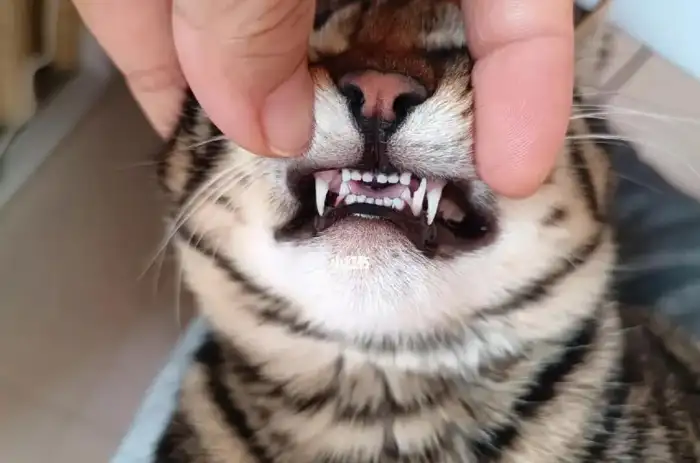Maintaining good oral hygiene for your cat is essential for their overall health. Dental issues, particularly tartar buildup, can lead to serious health problems if not addressed. This article will guide you through the steps to prevent tartar buildup in your cat’s mouth, ensuring they maintain a healthy smile.

1. Understanding Tartar Buildup in Cats
What Is Tartar?
Tartar, also known as calculus, is a hardened form of dental plaque that accumulates on teeth over time. It develops when plaque—a sticky film of bacteria—mineralizes and hardens due to saliva and food particles.
Symptoms of Tartar Buildup
Recognizing the signs of tartar buildup early is crucial:
- Bad Breath: Persistent foul odor from your cat’s mouth.
- Yellowish Brown Teeth: Noticeable discoloration on the teeth.
- Gum Inflammation: Red or swollen gums around the teeth.
- Difficulty Eating: Reluctance to chew or play with toys.
2. Regular Dental Check-ups
Importance of Veterinary Visits
Routine veterinary check-ups play a vital role in your cat’s dental health:
- Professional Cleanings: Your veterinarian can perform professional cleanings to remove tartar that regular brushing might miss.
- Early Detection: Regular check-ups allow for early detection of dental issues before they escalate.
Recommended Frequency
- Every Six Months: For most cats, a dental check-up every six months is advisable. Older cats or those with existing dental problems may require more frequent visits.
3. Daily Dental Care at Home
Brushing Your Cat’s Teeth
Daily brushing is the most effective way to prevent tartar buildup:
- Choose the Right Toothbrush and Toothpaste: Use a toothbrush designed for cats and a toothpaste specifically formulated for felines. Human toothpaste can be toxic to cats.
- Establish a Routine: Start by allowing your cat to get accustomed to the toothbrush. Gradually introduce brushing, aiming for daily sessions.
How to Brush Your Cat’s Teeth
- Get Comfortable: Find a quiet space and make your cat comfortable.
- Introduce the Toothbrush: Let your cat sniff the toothbrush and toothpaste.
- Start Brushing: Gently lift your cat’s lip and brush in a circular motion, focusing on the gum line.
- Reward Your Cat: After brushing, reward your cat with a treat or extra affection.
4. Choosing the Right Diet
Dental Health and Nutrition
The food you choose can significantly impact your cat’s oral health:
- Dry vs. Wet Food: Dry kibble can help reduce plaque compared to wet food, which may contribute to tartar buildup.
- Dental Diets: Consider special dental diets formulated to promote oral health. These kibbles often have a texture that helps scrub teeth as your cat chews.
Foods to Avoid
- High Sugar Foods: Steer clear of foods high in sugars and starches, which can promote plaque formation.
5. Dental Chews and Toys
Benefits of Dental Chews
Dental chews are an excellent addition to your cat’s oral care routine:
- Promote Chewing: Chewing on dental treats can help remove plaque and tartar.
- Variety of Options: Look for treats specifically designed to promote dental health, ensuring they are safe for your cat.
Interactive Toys
- Chew Toys: Providing rubber or fabric chew toys can help clean teeth and keep your cat entertained.
- Feather Wands: Engaging your cat in play helps keep them active, which indirectly benefits their overall health.
6. Using Water Additives
What Are Dental Water Additives?
Dental water additives can be an effective way to promote oral hygiene:
- How They Work: These products are mixed with your cat’s drinking water and contain ingredients that help reduce plaque and freshen breath.
Choosing Safe Products
- Consult Your Vet: Always check with your veterinarian before introducing any new products to ensure they are safe and effective for your cat.
7. Recognizing the Signs of Dental Disease
Early Detection
Being vigilant about your cat’s dental health can help catch issues early:
- Changes in Eating Habits: If your cat suddenly becomes reluctant to eat or shows signs of pain while chewing, it may indicate dental problems.
- Behavioral Changes: Increased irritability or aggression can sometimes be linked to dental pain.
When to Seek Veterinary Help
- Persistent Symptoms: If you notice any signs of dental disease, consult your veterinarian for a thorough examination.
8. Creating a Routine
Establishing a Dental Care Schedule
To ensure your cat’s oral hygiene is maintained, create a routine:
- Daily Brushing: Aim for daily brushing sessions.
- Regular Vet Visits: Schedule dental check-ups as recommended by your veterinarian.
- Monitor Diet: Keep track of what your cat eats and adjust their diet for optimal dental health.
Consistency is Key
Consistency in your dental care routine will yield the best results in preventing tartar buildup and promoting your cat’s overall health.
9. Conclusion
Maintaining your cat’s oral hygiene is crucial for their health and well-being. By following these steps to prevent tartar buildup—regular vet visits, daily dental care, proper nutrition, and the use of dental chews—you can ensure your cat enjoys a happy and healthy life. Don’t underestimate the importance of oral hygiene; your cat’s health depends on it.

Comments (0)